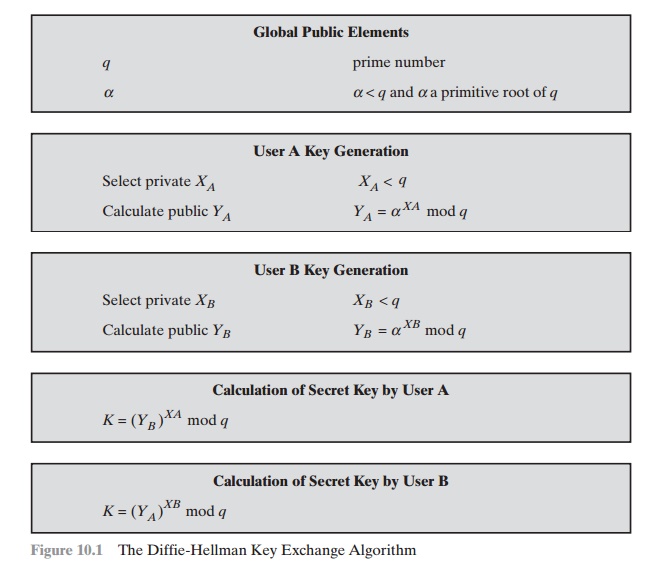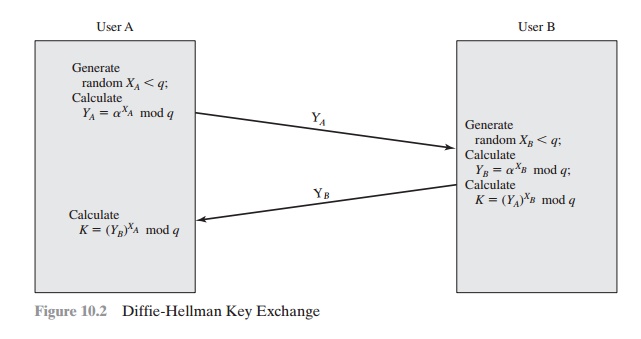Chapter: Cryptography and Network Security Principles and Practice : Asymmetric Ciphers : Other Public-Key Cryptosystems
Diffie-Hellman Key Exchange
DIFFIE-HELLMAN KEY EXCHANGE
The first published public-key algorithm
appeared in the seminal paper by Diffie and Hellman that defined public-key
cryptography [DIFF76b] and is generally referred to as Diffie-Hellman key
exchange. A
number of commercial products employ this key exchange technique.
The purpose of the algorithm is to enable
two users to securely exchange
a key that can then be used for subsequent encryption of messages. The algorithm
itself is limited to the exchange
of secret values.
The Diffie-Hellman algorithm depends for its effectiveness on the difficulty of computing discrete logarithms. Briefly, we can
define the discrete logarithm in the following way. Recall from Chapter 8 that a primitive root of a prime
number p
as one whose powers
modulo p generate all the integers
from 1 to p - 1. That is, if a is a
primitive root of the prime
number p, then the numbers
a
mod p,
a2 mod p, Á , ap - 1 mod p
are distinct and consist of the integers
from 1 through p - 1 in some permutation.
For any integer b and a primitive root a of
prime number p, we can find a unique
exponent i such that
b K ai (mod p) where
0 … i … (p - 1)
The exponent i is
referred to as the discrete logarithm of
b for the base a, mod p. We express this value as dloga,p(b). See Chapter
8 for an extended discussion of discrete logarithms.
The Algorithm
Figure 10.1 summarizes the Diffie-Hellman key exchange
algorithm. For this scheme, there are two publicly
known numbers: a prime number
q
and an integer
a that is a primitive root of q. Suppose
the users A and B wish to exchange a key. User
A
selects a random integer XA 6 q and computes YA = aXA mod q. Similarly,
user B independently selects a random integer XB 6 q and computes YB = aXB mod q. Each side keeps
the X value private
and makes the Y value available publicly to the other side. User A computes the key as K = (YB)XA mod q and user B computes the key as K = (YA)XB mod q . These two calculations
produce identical results:
K = (YB)XA mod q
= (aXB mod q)XA mod q
= (aXB)XA mod q by the
rules of modular arithmetic
= aXBXA mod q
= (aXA)XB mod q
= (aXA mod q)XB mod q
= (YA)XB mod q
The result is that the two sides have exchanged a secret
value. Furthermore, because XA and XB are private, an adversary only has the following
ingredients to work with: q, a, YA, and YB. Thus, the adversary is forced to take a discrete logarithm to determine the key. For example,
to determine the private key of user B, an adver-
sary must compute
XB = d
loga,q(YB)
The adversary can then
calculate the key
K
in the same
manner as user
B calculates it.

The security of the Diffie-Hellman key exchange lies in the fact that,
while it is relatively easy to calculate exponentials modulo a prime, it is very difficult to calcu-
late discrete logarithms. For large primes,
the latter task is considered infeasible.
Here is an example. Key exchange is based on
the use of the prime number q = 353
and a primitive root of 353, in this case a = 3. A and B select secret keys XA = 97
and XB = 233, respectively. Each computes its public key:
A computes YA = 397 mod 353 = 40. B computes YB = 3233 mod 353 = 248.
After they exchange public keys, each can
compute the common secret key:
A
computes K = (YB)XA mod
353 = 24897 mod
353 = 160.
B computes K = (YA)XB mod 353 = 40233 mod
353 = 160.
We assume an attacker would have available
the following information:
q
= 353; a = 3; YA = 40; YB = 248
In this simple example, it would be possible
by brute force to determine the secret key 160. In particular, an attacker E
can determine the common key by discovering
a solution to the equation 3a mod 353 = 40 or the equation 3b mod
353 = 248. The brute-force
approach is to calculate powers of 3 modulo 353, stopping when the result equals either 40 or 248. The desired
answer is reached with the exponent value of 97, which provides 397 mod 353 = 40.
With larger numbers, the problem becomes
impractical.
Key Exchange Protocols
Figure 10.2 shows
a simple protocol
that makes use of the Diffie-Hellman calcula- tion. Suppose that user A wishes
to set up a connection with user B and use a secret key to encrypt messages
on that connection. User A can generate a one-time private key XA, calculate YA,
and send that to user B. User B
responds by generating a pri- vate value
XB, calculating YB, and sending
YB to user A. Both users can now calcu-
late the key. The necessary public values q and
a would need to be known
ahead of time. Alternatively,
user A could pick values for q and a and include those in
the first
message.
As an example
of another use of the Diffie-Hellman algorithm, suppose that a group
of users (e.g., all users on a LAN) each generate
a long-lasting private
value Xi (for user i) and
calculate a public value Yi. These public values, together with global public values for q
and a, are stored in some central
directory. At any time,
user j can access user i’s public value, calculate a secret key, and use that to send an
encrypted message to user A. If the central directory is trusted, then this
form of communication provides both
confidentiality and a degree of authentication.
Because only i and j can determine the key, no other user can read the message
(confidentiality). Recipient i knows
that only user j could have created a
message using this key (authentication). However, the technique does not
protect against replay attacks.

Man-in-the-Middle Attack
The protocol depicted
in Figure 10.2 is insecure
against a man-in-the-middle attack. Suppose Alice and
Bob wish to exchange keys, and Darth is
the adversary. The attack proceeds as follows.
1.
Darth
prepares for the attack by generating two random private
keys XD1 and
XD2 and then computing the corresponding
public keys YD1 and YD2.
2.
Alice transmits YA to Bob.
3.
Darth intercepts YA and
transmits YD1 to Bob. Darth
also calculates K2 = (YA)XD2 mod q .
4.
Bob receives YD1 and calculates K1 = (YD1)XB mod q .
5.
Bob transmits
YB to Alice.
6.
Darth intercepts
YB and transmits YD2
to Alice. Darth
calculates K1 = (YB)XD1 mod q
7.
Alice receives YD2 and calculates K2 = (YD2)XA mod q .
At this point, Bob and Alice think that they share a secret key, but instead Bob and Darth share secret key K1 and Alice and Darth share secret key K2. All
future communication between Bob and Alice
is compromised in the following way.
1.
Alice
sends an encrypted message M: E(K2, M) .
2.
Darth intercepts the encrypted
message and decrypts
it to recover M.
3.
Darth sends Bob E(K1, M) or
E(K1, M¿) , where M¿ is any message. In the first
case, Darth simply wants to eavesdrop on the communication without altering it.
In the second case, Darth wants to modify the message
going to
Bob.
The
key exchange protocol is vulnerable to such an attack because it does not
authenticate the participants. This vulnerability can be overcome with the use of digital signatures and public-key certificates; these topics
are explored in Chapters 13 and 14.
Related Topics